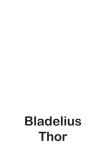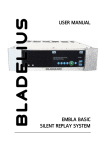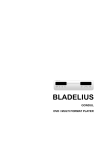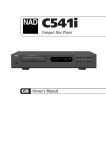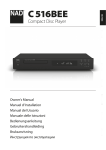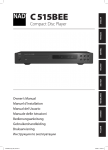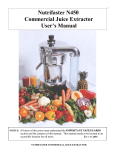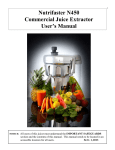Download Advantage S1 Owner`s manual
Transcript
S1 DISC PLAYER _____________________________________________________________________ ____ S1 DISC PLAYER OWNER’S MANUAL ___________________________________________________________________ _____ Page 0 S1 DISC PLAYER _____________________________________________________________________ ____ This symbol is intended to alert you to the presence of uninsulated, dangerous voltage within the unit’s case that may be sufficient magnitude to constitute a risk of electric shock. This symbol is intended to alert you to the presence of important operating and maintenance instructions in the literature accompanying this unit. _____________________________________________________________________ ____ To prevent fire or shock hazard, do not expose this unit to rain or moisture. Do not remove the cabinet cover, or you may be exposed to dangerous voltage. Refer servicing to qualified service personnel only. _____________________________________________________________________ ____ The “CE ” symbol (shown left) indicates compliance of this device with the EMC (Electromagnetic Compatibility)and LVD (Low Voltage Directive) standards of the European Community. The information contained in the manual is subject to change without notice. The most current version of this manual will be posted on our web site at http://www.bladelius.com. ___________________________________________________________________ _____ Page 1 S1 DISC PLAYER _____________________________________________________________________ ____ Introduction Thank you for purchasing the ADVANTAGE S-1 Disc-player. Your S-1 is a state-of-the-art unit, and has been assembled by highly skilled ADVANTAGE craftsmen to provide you with many years of listening pleasure. Our unit’s esteem arises from the way we handle music-signals. ADVANTAGE develops products for people who wish absolutely natural and enjoyable music reproduction. “BURN-IN” Due to the extremely short signal paths designed and built into this piece of equipment, a significant "burn-in" period is required before the unit will reach its maximum sonic potential. We recommend the unit be left on (or in standby mode) at all times, especially during the first 5-6 weeks of operation, in order to speed the "burn-in" process. For best results, the S-1 should be left on or in the standby mode at all times. The unit should not be switched off via the master ON/OFF switch unless the unit will not be being used for a significant period of time (during vacations, etc.). Design Reduction is the principle for the shaping of all ADVANTAGE components. The unobtrusive design harmonizes with almost every environment and does not compete with your personal sphere. The form refers to the tonal ability of the product line, whose composure and strength manifests a well-balanced equilibrium. Balanced signal transmission Balanced signal transmission means that two signal lines are used which carry the same signal with opposite phase. On the receiving side, the signals are mixed. Since any noise interference that has arisen during transmission will be present in both lines with identical phase, such noise is cancelled out, leaving only the pure original signal. Balanced connection therefore keeps the signal transfer free from any kind of interference. ___________________________________________________________________ _____ Page 2 S1 DISC PLAYER _____________________________________________________________________ ____ Unpacking When you have received your S-1, you should make sure that the shipping box is in its original state. If however that should not be the case, please contact your dealer. Please unpack your unit carefully; there are several parts that can be damaged. We suggest that you to keep your box and shock absorbers. Save your plastic bag, inserts, and carton. You may need these later for transporting the S-1 or for shipment in the event it ever requires factory service. Record the serial number (on rear panel) here for future reference: ____________________ Please make sure that your shipping box contains the following: 1 pc ADVANTAGE S-1 1 pc Remote control 1 pc Power cord 2 pcs Batteries LR03 (AAA) Cleaning To clean the unit, use only a soft tissue (Kleenex type). Never apply abrasive cleaners to the outer surfaces of the unit. Note! At no time should liquid cleaners be applied directly to the S-1, as direct application of liquids may result in damage to electronic components within the unit. Installation Install the Compact Disc player on a level, vibrationfree surface. Severe vibration, or operation in a tilted position, may cause the player to mis-track. The player may be stacked with other stereo components, as long as there is adequate ventilation around it. If the player is placed in close proximity to a radio tuner (AM or FM), a VCR, or a television set, the operation of its digital circuits may produce interference that would affect reception of weak broadcast signals. If this occurs, move the CD player away from other devices or switch it off when viewing or listening to broadcasts. ___________________________________________________________________ _____ Page 3 S1 DISC PLAYER _____________________________________________________________________ ____ Playing Compact Discs 1. Connect a stereo cable from the L (left) and R (right) Line Output jacks (Choose either balanced or unbalanced outputs according to what your amplifier accepts) to the corresponding CD inputs on your amplifier. 2.Connect the detachable AC power cord to the rear panel. 3.Plug the AC power cord into a functioning wall outlet. panel. 4. Activate the player’s main switch on the back 5. Turn the player on with the DIM/STANDBY button 6. Press the STOP/DRAWER button a while to open the disc drawer. 7. Place a CD, label side up, in the tray's circular recess. Be certain that the disc is centred within the recess. 8. Press PLAY/PAUSE. The drawer closes automatically, and the disc begins to play. 9. At any time you may press SKIP 9 or : to select different tracks on the disc. 10. Press PLAY/PAUSE if you want to stop play temporarily while keeping the pickup at its current position on the disc. (Press PLAY/PAUSE again when you want to resume playback.) Press STOP/DRAWER once if you want to end play and re-set the pickup to the beginning of the disc, twice to open the drawer. ___________________________________________________________________ _____ Page 4 S1 DISC PLAYER _____________________________________________________________________ ____ REAR PANEL CONNECTIONS This Player is designed as a modular design allowing for plugging in different modules for different features and performance. There is totally four slots for different plug in modules. In this version two of these are used, One is the digital input/Output/DAC section and the other one is the analogue output section. Different modules will be developed to either add new features or to upgrade the existing ones. From left to right DIGITAL INPUTS (Slot 1) 1. Balanced digital input. AES/EBU standard, 600 ohms. This is a professional standard digital input, permitting the ultimate in high quality digital transmission with the best associated equipment. The serial data output is taken after error correction but before digital-to-analog conversion and filtering. The input is transformer-isolated from the built-in D-to-A circuits. 2. Unbalanced digital coaxial input S/P DIF format To use the digital input, connect a cable from this jack to the digital output or equivalent output on a digital signal source (DVD-player, MD-player or computer sound card). For best results the cable should be a 75-ohm coaxial cable of the type used for video signals, with a BNC connection at each end. 3. Optical digital input, Toslink, S/P DIF format This jack accepts the digital audio input signal from a compatible digital audio product. DIGITAL OUTPUTS 1. Balanced digital output. AES/EBU standard, 600 ohms. This is a professional standard digital output. The signal is available from the XLR/Cannon connector marked AES/EBU DIGITAL OUT, permitting the ultimate in high quality digital transmission with the best associated equipment. The serial data output is taken after error correction but before digital-to-analog conversion and filtering. The output is transformer-isolated from the built-in D-to-A circuits. 2. Unbalanced digital coaxial output S/P DIF format The digital playback signal is available at this output also. It may be connected to any digital signal processor that conforms to the Sony/Philips (SPDIF) standard. To use the digital output, connect a cable from this jack to the "CD digital" or equivalent input on a digital processor. For best results the cable should be a 75-ohm coaxial cable of the type used for video signals, with a BNC connection at each end. 3. Optical digital output, Toslink, S/P DIF format Use this output if the receiving component only is equipped with an optical input. ___________________________________________________________________ _____ Page 5 S1 DISC PLAYER _____________________________________________________________________ ____ ANALOG OUTPUT (Slot 2) 1. BALANCED LINE OUTPUT Connections to an amplifier or preamplifier that uses balanced XLR input connectors, such as ADVANTAGE S100 or S2 or directly to your S150 or S250 power amplifiers. Balanced signal transmission provides far better suppression of outside electrical interference and shielding. The wiring standard used for these connectors is: Pin 1:Chassis Earth (GROUND) Pin 2:Hot (+ OUT) Pin 3:Signal Ground (- OUT) 2. UNBALANCED LINE OUTPUT Connect an RCA cable from these jacks to your amplifier. Plug one end of a stereo audio cable into the Left (upper) and Right (lower) output jacks. Connect the other end of the cable to your stereo amplifier's CD input, or to any other "line-level" input jacks (such as the AUXiliary inputs). Do NOT connect this cable to any amplifier's PHONO input jacks. Make sure that the plugs are pushed home properly. THE BENEFITS OF BALANCED CONNECTIONS With a conventional (unbalanced) connection, audio signal current flows from the CD player to the amplifier via the cable’s centre conductor. To complete the circuit, audio signal current flows back to the CD player ground via the cable’s outer conductor. The outer conductor also serves as the cable’s shield. When two audio components are connected together, power-supply noise and “leakage” hum may also flow on the cable shields, combining with the return audio current. The resulting distortion and noise may depend on the orientation of AC power plugs in their sockets. Designers of some audiophile cables combat this contamination by leaving the shield unconnected at one end. Since the shield is grounded at only one end, the performance of such a cable may depend on the direction of its connection, i.e. whether the shield is grounded at the CD player or at the amplifier. A three-wire balanced connection avoids all of these uncertainties. The signal “hot” and return currents are both carried on inner conductors. The separate cable shield, connected to the amplifier chassis at both ends, protects the audio signal from all forms of interference and power-supply noise. Slot 3 and 4 are nor used in this configuration DATA COM and RS232 connections The Data Com connection is used to exchange information between different Advantage products. The RS232 port is used to control or program the unit from an external controller or computer MAIN POWER SWITCH Press this switch to switch on the power to the player. Switch the unit off only if it is not going to be used for a longer period. IEC AC MAINS (POWER) INPUT The S1 comes supplied with a separate AC Mains cable. Before connecting the cable to a live wall socket ensure that it is firmly connected to the ADVANTAGE S1’s AC Mains input socket first. Always disconnect the AC Mains cable plug from the live wall socket first, before disconnecting the cable from the S1 Mains input socket. ___________________________________________________________________ _____ Page 6 S1 DISC PLAYER _____________________________________________________________________ ____ FRONT PANEL Display windows Left display This display shows all “transport” functions of the player such as track info, playing time, repeat selections and CD-Text info (if present on the disc). Right display This display shows all DAC and output stage functions and settings of the player. It shows What (digital) input is selected: CD, BNC, Toslink, Balanced (Where CD stands for the built in transport (default usage)) It also shows volume control setting if the volume control is activated. This window also shows all other settings made by pressing DISP/EDIT on the remote control. Both these displays can be dimmed (i.e. shut off) by pressing the Dim/Display button on the remote control. In this setting the display will light briefly when any setting or control is used. Controls, Left to right 1. STOP/DRAWER Press and hold this button to open the disc drawer, and press it again to close the drawer. If this button is pressed briefly once while a disc is being played, the playback will stop and the pickup will re-set to the beginning of the disc. To open the drawer, press and hold the button. When the disc drawer is open, the drawer-closing mechanism can also be activated by pressing PLAY/PAUSE. CAUTION: DO NOT try to close the drawer by pushing it in by hand, regardless if the player is ON or switched OFF. The disc drawer is opened and closed by an internal motor, which may be damaged if forced. When the drawer closes, the player scans the disc's "table of contents" and displays the number of tracks and total playing time on the disc. If you press PLAY/PAUSE to close the drawer, this display is skipped, and play commences immediately at Track 1. If the CD is recorded with “CD-TEXT” information, the title of the album and the artist name will be displayed. 2. SKIP Back 9 and SCAN Back button These functions are combined in one SKIP/SCAN Back button. One press skips back to the beginning of the track. Press 9twice to skip back to the previous track and so on. If you try to SKIP Back past the first track on the disc, the first track will be played. The SCAN Back function is activated by pressing the same button, but keeping it depressed for more than 1 second. This causes the laser to scan backwards continuously, first slowly, after a few seconds rapidly, until the button is released. This button works in PLAY, PAUSE or STOP mode. After loading a new disc, you must press PLAY/PAUSE before the scan circuit will work. If the scan is initiated while the player is in PAUSE, the scan is silent. If the scan is initiated during PLAY, the music will be heard in fragmentary form at reduced volume as the player scans through it. Use this "audible scan" to cue the player precisely to the spot where you want to resume play. If you scan back to the beginning of the disc while playing Track 1, the player stops scanning and resumes PLAY or PAUSE when you let go of the button. ___________________________________________________________________ _____ Page 7 S1 DISC PLAYER _____________________________________________________________________ ____ 3. PLAY/PAUSE This dual-function button alternates between starting and stopping playback. Press to start play or to resume play after pause. During play, press this button to stop playback temporarily, keeping the laser at its current position on the disc. The play mode is identified by the “4” icon in the display. In the pause mode, the “;” icon is displayed instead. To resume playback at the exact point where it stopped, press PLAY/PAUSE again. If you don't want to resume play at the same point, you may use the SKIP controls to cue the pickup to a different starting point before pressing PLAY/PAUSE again. 4. SKIP Forward :and SCAN Forward The : functions are combined in one SKIP/SCAN Forward button. During play, pressing SKIP Forward : will jump to the beginning of the next track and resume play there. Thus, to sample each song on a disc, press PLAY/PAUSE and then tap SKIP Forward : after you've heard a few seconds of each track. If you try to SKIP Forward past the last track on the disc the player will play the last track on the disc. The SCAN Forward function is activated by pressing the same button, but keeping it depressed for more than 1 second. This causes the laser to scan rapidly forward through the music. The behaviour of this function is similar to SCAN Back. If you scan forward to the end of the disc while playing the final track, the scan will stop and the display will show “-OVER-“. When you let go of the button, the player switches to STOP mode. 5. MENU This button cycles through the different options and settings that can be programmed on the player 6. VOLUME – By pressing this button you lower the volume from the player. 7. VOLUME + By pressing this button you lower the volume from the player. Observe: These two buttons are only active when the player is set to Volume control enabled. Read more about this function in “Programming your S1” 8. DIM/STANDBY If you press this button briefly you can switch the displays on and off. When you are in “OFF” mode the player will show all changes briefly before shutting the display again (i.e. changing volume setting, skipping etc.) If you press this button for more than a second the player switches off to standby mode. Press again to switch it on. For best results, the S-1 should be left on or in the standby mode at all times. The unit should not be switched off via the master ON/OFF switch unless the unit will not be used for a significant period of time (during vacations, etc.). ___________________________________________________________________ _____ Page 8 S1 DISC PLAYER _____________________________________________________________________ ____ Remote control 1. 2. 3. 4. 5. 6. 7. 8. 9. 10. 11. 12. 13. 14. 15. PRE/CD/DAC activates the different functions of each ADVANTAGE product. CD and DAC activate the functions on S-1. EXT activates other ADVANTAGE products which are connected via data-com. CMD gives access to the different commands available on the selected unit. DISPLAY to get a quick overview of the current settings in DAC mode. EDIT changes the names of the inputs. SOURCE selects the digital input to be used. REC/PHASE Changes absolute phase on S-1 when in DAC mode. SKIP hold button: forward and rewind, push button: track forward and rewind. SURR/MODE Turns resampling on and off in DAC mode. STOP push button to stop player. OPEN hold button for a second to open. PLAY starts playing the CD. PAUSE VOL + /- volume settings (if activated). MUTE/REPEAT Silences the player in DAC mode. Activates the repeat function in CD mode. BAL +/- balance settings (only on preamplifier). DIM adjusts the display brightness with a push on the button. STANDBY switches the unit between operation and standby mode when you hold the button. The volume control function The S-1 is equipped with a state-of-the-art output stage with a built in volume control. This enables the user to connect the S-1 directly to your power amplifier/s. The volume control is controlled with the two buttons on the front panel or the two buttons on the bottom left on the remote control. Before you connect the S-1 directly to any power amplifiers you must verify that the volume control is active. Press the DISPLAY button (4) on the remote until “VOL CTRL ENA” or “VOL CTRL OFF” is shown in the right display. If the setting is “OFF” you must switch it on by pressing either of the volume control buttons on the remote to toggle the function to “VOL CTRL ENA” which means that the volume control is enabled. As always, do not make any connections unless all equipment is switched off! Source selection In DAC mode on the remote control you can select what digital source the DAC will encode. To use the S-1 as a regular CD-player this setting is “CD” (factory default). By pressing either of the source buttons you will cycle through the different digital inputs on the player. Absolute Phase The S-1 is equipped with a function to change the polarity or absolute phase of the signal output. This is done by pressing, in DAC-mod, the REC/PHASE button (6). The right display will show the status. ___________________________________________________________________ _____ Page 9 S1 DISC PLAYER _____________________________________________________________________ ____ Resampling The D/A converter in S-1 can handle resolution up to 24bits/96kHz. It is possible to get even better sound quality from CD’s by resampling the original 16bit/44.1kHz up to 24bits/96kHz. The factory default position of this feature is ON but it can be controlled by the user. In DAC mode, press MODE to toggle this function ON and OFF. ___________________________________________________________________ _____ Page 10 S1 DISC PLAYER _____________________________________________________________________ ____ Installing and replacing batteries. The remote control requires two 1.5-volt AAA-size (i.e. UM-4 or IEC RO3) cells. Alkaline cells are recommended to obtain maximum operating life. To open the battery compartment, unscrew the lid on the back of the remote control unit. Install fresh cells, orienting them as shown on the diagram within the compartment. The coil springs should contact the (-) end of each cell. Put the battery compartment cover back on and fasten the screws. In some cases, poor operation may be caused by corrosion or fingerprint oil on the battery contacts. Remove both cells, rub the metal contacts at both ends of each cell with a clean cloth or a pencil eraser, and re-install the cells, being careful to orient them correctly. MAINTENANCE At periodic intervals, open the disc drawer and wipe with a damp cloth to remove any loose dust. HANDLING COMPACT DISCS Handle Compact Discs with care. The playback of a disc will not be impaired by small dust particles, a few light fingerprints, or slight scratches. But large scratches, or a thick layer of oily fingerprints, can prevent the player from tracking the disc. (Incidentally, although the tracking laser "plays" the disc through its clear side, the actual data surface is embedded directly beneath the label, protected only by a very thin coating of lacquer. So a scratch that cuts through the label may damage the disc more than a similar scratch on the transparent "playing" surface. You should treat both surfaces of the disc with care.) Severe scratches or fingerprints may cause the player to miss-track (skipping ahead, or repeating the same passage). Less severe damage may produce very brief bursts of high-frequency noise. The tracking and error-correction circuits of this ADVANTAGE CD player are unusually sophisticated, providing secure tracking of flawed discs that are unplayable on some other players. Nevertheless, the discs should not be abused or handled carelessly. CLEANING DISCS Soiled discs may be cleaned by wiping with a soft cloth, either dry or moistened with water. Do NOT use conventional LP record-cleaning products (cleaning solutions, sprays, treated cloths, or anti-static preparations), nor any kind of chemical solvent (alcohol, benzene, et al). A severely soiled disc may be washed in a warm-water spray, possibly with a small amount of a mild kitchen detergent added, and then wiped dry with a clean, soft towel. When cleaning the disc, use only RADIAL strokes (from center to edge). Never use a circular wiping motion like that used for cleaning ordinary LP records, because in wiping the disc there is a risk of scratching it. A radial scratch will do the least harm because it affects only a small portion of each circular data track, which can be fully compensated by the player's error-correction circuits. But a circular scratch that follows a data track may damage such a long continuous segment of data that it cannot be corrected. Problem NO POWER. DISC PLAY DOES NOT START. • • • TROUBLESHOOTING Cause Power Mains cable unplugged or power not switched on. The disc is loaded upside down. The disc is too dirty. • • • Solution Check if AC Mains cable is plugged in and power switched on. Reload the disc with the label side UP. Clean the disc. ___________________________________________________________________ _____ Page 11 S1 DISC PLAYER _____________________________________________________________________ ____ NO SOUND. • Incorrect audio cable • Connect the CD player to connections. the amplifier/ receiver correctly. • Incorrect • Make sure that the input amplifier/receiver selector on your amplifier operation. or receiver is set correctly. SOUND SKIPS. • The CD player is subject • Change the installation to vibration or physical location. shock from external sources. • Disc is dirty. • Clean the disc. A “HUMMING “SOUND CAN • Loose cable connections. • Check the cable BE HEARD. connections, particularly the phono connecting cable. REMOTE CONTROL NOT • Batteries flat, or • Check or replace WORKING. incorrectly inserted. batteries. • IR transmitter or receiver • Remove obstruction. windows obstructed. 1.) In the event of a fuse failure, locate the fuse access hatch under the AC mains plug. Replace the fuse only with the exact type originally provided with the S-1. Substitution of a larger fuse will void your warranty. 2.) If only one channel remains inoperative, try reversing the Left and Right cables to your pre or power amplifier (always turn it off before moving wires). If the same channel stays out, it indicates trouble could be other than your disc player itself. 3.) Many functions of the S-1 is controlled only by the remote control handset. If the unit does not respond to commands from the remote control, the batteries may have expired. To replace the batteries, open the battery access door on the back of the remote control and replace the two R03 (AAA) batteries. Make sure that the remote control sensor window on the front of the unit and the remote control emitter lens are kept clean and dust free. WARRANTY Contact your authorized ADVANTAGE dealer for details of our warranty policy. OBTAINING SERVICE If your ADVANTAGE component must be serviced, please contact your dealer. Your dealer will then decide whether the problem can be remedied locally, or whether to contact ADVANTAGE for further service information or parts, or to obtain a Return Authorization. Important! Return authorization must be obtained from our Technical Services Department BEFORE a unit is shipped for Service. It is extremely important that information about a problem be explicit and complete. A specific, comprehensive description of the problem helps your dealer and the Technical Services Department locate and repair the difficulty as quickly as possible. A copy of the original bill of sale will serve to verify warranty status. Please include it with the unit when it is brought in for warranty service. Warning! ___________________________________________________________________ _____ Page 12 S1 DISC PLAYER _____________________________________________________________________ ____ All returned units must be properly packaged (preferably in their original packing material), and the proper return authorization numbers must be marked on the outer carton for identification. If the packaging to protect the unit is, in our opinion or that of our dealer, inadequate to protect the unit, we reserve the right to repackage it for return shipment at the owner’s expense. Neither ADVANTAGE nor your dealer can be responsible for shipping damage due to improper (that is, non-original) packaging. Your dealer can order a new set of shipping materials for you if you need to ship your component and no longer have the original materials. There will be a charge for this service. We strongly recommend saving all packing materials in case you need to ship your unit some day. © 2002 Bladelius Design Group ___________________________________________________________________ _____ Page 13














